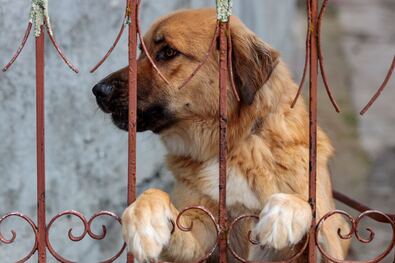|
If I could have one New Year’s wish, it would be to let people know that we don’t HAVE to see a behaviour to know what you're talking about.
For an in-home consultation with a new dog, one of our safety protocols is that the dog is shut away in a crate, or in another room, when we arrive. This is especially emphasised when the dog has a history of aggression, but we ask for it for every single consultation - even if we are working on more obedience based concepts. An exception can be made for puppy consultations. We get questioned on the regular as to why this is the case, and this blog is going to explain it for you. Hopefully you will understand the reasons behind this choice, and then you can spread the word for us! As dog trainers, we’ve met and seen a lot of dogs. On average, I can confidently say that we’ve seen a lot more than the regular dog owner, as well as the variety of behaviours dogs can display. When someone says to us, ‘my dog rushes at the window and barks like a maniac when a person turns up at the front door’, we know what you mean. Same goes for: ‘He lunges at the end of the lead at other dogs,’ ‘She can’t settle down and whines if we put her in the other room to go to work,’ ‘He’s growling at my young nephew,’ And so on and so forth. We know what all of these behaviours look like, and if you can adequately describe what you see your dog doing in a certain situation, we believe you. If you can’t adequately explain it, we have a repertoire of questions that will help give us the full picture, including ones about body language, context cues, and past history. It can set a whole consultation up to go wrong, when a person doesn’t listen to our instruction of putting the dog away before we arrive. Many of our cases deal with stranger danger, and there is a set way we want to be introduced to the dog. If the consultation opens with the dog rushing the window and ‘acting like a maniac’, every single participant starts off on the wrong foot. Think back to where I said we ask a lot of questions. This process cannot occur if the dog is leaping all around the place, or you are trying to manage the dog in any range of behaviours, while also trying to think about answers to sometimes more complicated questions. ‘But we just wanted you to see what they do!’ This is a dangerous idea. Even if a dog has never bitten before, behaviour can always escalate. When we come to a home, we are strangers with bags, coming right through your front door, and there can sometimes be more than one trainer. This could easily put your dog into a place where it’s no longer just barking, and could turn into something more. The trainers then get put in harm's way. Think of it this way: if we were to go to a consultation where there had been aggression shown toward children, do you think it would be in any way appropriate to go ask the neighbour for their four year old child so ‘we can see what the dog does’? Exactly. The set up of an environment is key, and that is what we want to demonstrate in a lot of instances. We need to train the dog when they are in a position to listen and learn. This cannot happen if they are overstimulated, in the presence of things that stress them out, or if they feel unsafe. We train dogs in a state called ‘under threshold’. This means they can engage with instructions from the handler, take food, and function in a more 'normal' way. If the dog is in a state where ‘their ears have turned off’, progress cannot be made. It’s not even just aggression where this is important. Over-excited behaviour needs the same kind of management and planning, so that the dog can actually focus. For example, if we’re trying to work with a dog who is showing leash pulling, taking them to a busy area to see them bark and lunge at the end of the lead means no learning can occur. We don’t need to see it, in fact, we don’t WANT to see the dog performing the behaviour. Not to mention that you will probably will be stressed and anxious if your dog was acting in such a way. You need to be in a learning state too! When we give you instructions about what to do with your dog before, or during a consultation (like being asked to put the dog away again, or that we move to somewhere else on a walk), we have some pretty good reasons as to why. A lot of them have to do with safety. The safety of you, your dog, members of the public, and us as trainers. We don’t need to see the behaviour, trust me. We believe you. Authored by Sarah Endres Dog Trainer and Behaviour Advisor
0 Comments
Leave a Reply. |
AuthorsArticles created by the team at Allsorts Dog Training, Bay of Plenty, New Zealand Our Library
All
|


 RSS Feed
RSS Feed